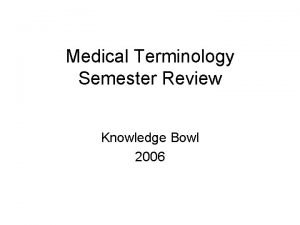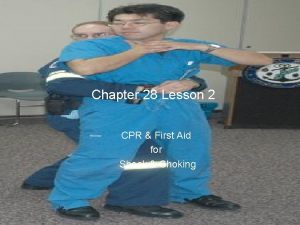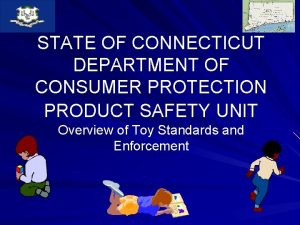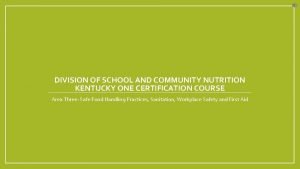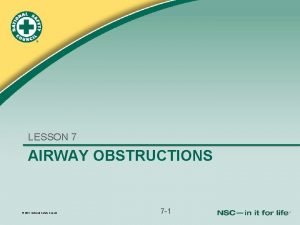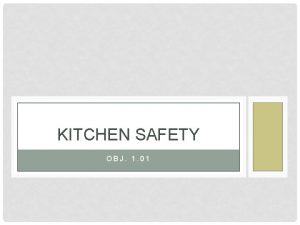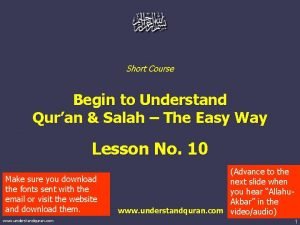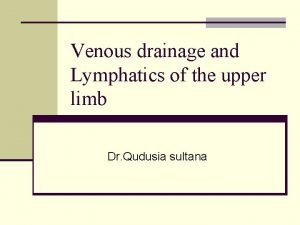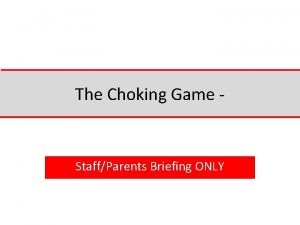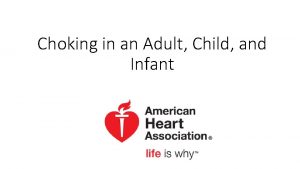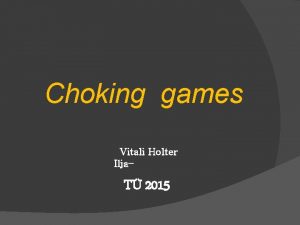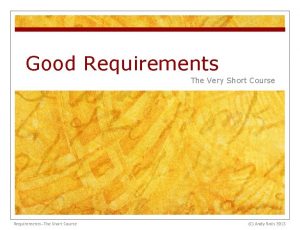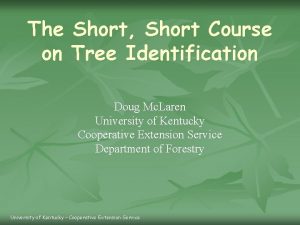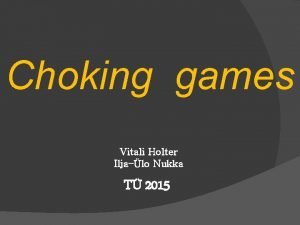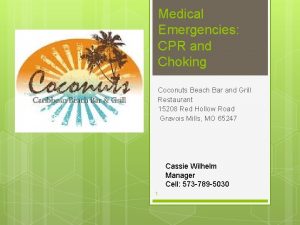Choking KS 2 Choking Choking A short course



















- Slides: 19

Choking KS 2 – Choking

Choking A short course to learn how to help someone who is choking.

Learning outcomes ➤ I can identify a casualty who is choking ➤ I can assess and give first aid to a casualty who is choking ➤ I can seek medical help if required

What do you see?

Choking Tasks: ➤ Name 3 things that you think are a choking hazard for toddlers ➤ Name 3 things that you think are a choking hazard for your age group ➤ Name 3 things that you think are a choking hazard for adults

Choking Basic anatomy ➤ We put the food we eat into our mouth, chew it and swallow. It then travels down our body in to our S_ _ _ _. ➤ We breathe air in through our mouth (and N_ _ _), this travels down a tube in our neck and into our lungs. ➤ At the back of the throat, there is a flap with the job of ensuring that food and air go to the correct places. ➤ Sometimes the flap doesn’t work fast enough and the airway can become B_ _ _ _.

Activity A 24 Digestion of food Students now have the opportunity to demonstrate their knowledge regarding the digestive process. Use our downloadable worksheet which can be found on slide 18 of this power point and on the St John Ambulance website.

Choking A 22 A SIGN is something you can see. Signs and symptoms of someone who is choking could be… A SYMPTOM is something that the casualty can feel.

Answers A 22 Signs and symptoms of someone who is choking could be: ➤ They may be unable to speak, breathe or cough ➤ The casualty's face or neck may become very red or look a purple or blue colour ➤ The may point to or grasp at their mouth or throat ➤ They may stand up and look very distressed ➤ They may look frightened with wide eyes ➤ They may become unresponsive Question: How could you tell someone you were choking if you could not speak? Explain your answer.

Watch this video https: //youtu. be/7 G 9 Pu. Awoow. I KS 2 – Choking

Your turn: Choking 1. 4. Ask the casualty if they are choking Give up to 5 ‘tummy’ thrusts (abdominal thrusts) 2. Encourage them to cough 5. If this is not successful call 999 or 112 for emergency help 3. Give up to 5 back blows using the heel of your hand between the shoulder blades 6. Repeat if necessary Do not forget to call for help. REMEMBER that your casualty could become unresponsive. Be prepared to perform CPR. KS 2 - Choking

Activity Recap quiz In pairs stand up and take it in turns to do the following: ➤ Show the part of your hand that you would use to give a back blow ➤ Point to where on your partners back you would give a back blow ➤ Show where you would press to do an abdominal thrust (tummy thrust).

Activity A 25 Choking word filler Students now have the opportunity to demonstrate their knowledge regarding choking. Use our downloadable worksheet which can be found on slide 19 of this power point and on the St John Ambulance website.

Check your learning I am able to: YES NO ➤ Identify when someone is choking ➤ Give first aid to a casualty who is choking ➤ Call for help correctly, if it is necessary |

Thank you!

Choking A 22 A SIGN is something you can see. Signs and symptoms of someone who is choking could be… A SYMPTOM is something that the casualty can feel.

Activity A 23 Word search This activity allows students to find topic key words from the word search. Download activity sheet ‘optional activity – word search’ from the St John Ambulance website.

Activity A 24 Digestion This activity allows students to demonstrate their knowledge of the digestive system. Download activity sheet ‘A 24 digestion’ from the St John Ambulance website. When we are eating, we move and taste food with our tongue, we use our teeth to chew food into pieces that are small enough to swallow. When this food is swallowed it travels into the oesophagus, this is a long tube that carries foods into the stomach. As food moves through the stomach it enters the small intestine, it then breaks down into pieces tiny enough to feed the cells in your body. Any pieces of food that the cells in your body do not need keep moving through the large intestine, this waste then leaves the body at the rectum. This whole process is known as digestion.

Activity A 25 extensions Choking word filler This activity allows students to demonstrate their learning on how to deal with a casualty who is choking. They should fill in the missing words from the sentences. Download activity sheet ‘A 25 – choking word filler’ from the St John Ambulance website.
 Long and short
Long and short Singulutus
Singulutus Universal sign of choking
Universal sign of choking Choking heimlich
Choking heimlich Choking hazard warning wording
Choking hazard warning wording Choking prevention
Choking prevention Heimlich maneuver
Heimlich maneuver 7 types of kitchen accidents
7 types of kitchen accidents Chaine parallèle muscle
Chaine parallèle muscle English bond t junction elevation
English bond t junction elevation Course title and course number
Course title and course number Blow out varicose veins
Blow out varicose veins Short saphenous vein course
Short saphenous vein course Understand quran and salah the easy way pdf
Understand quran and salah the easy way pdf Heterozygous tabby x stripeless
Heterozygous tabby x stripeless Story
Story Lymphatic of upper limb
Lymphatic of upper limb Vtac preferences
Vtac preferences Geo 702
Geo 702 Gress course
Gress course

